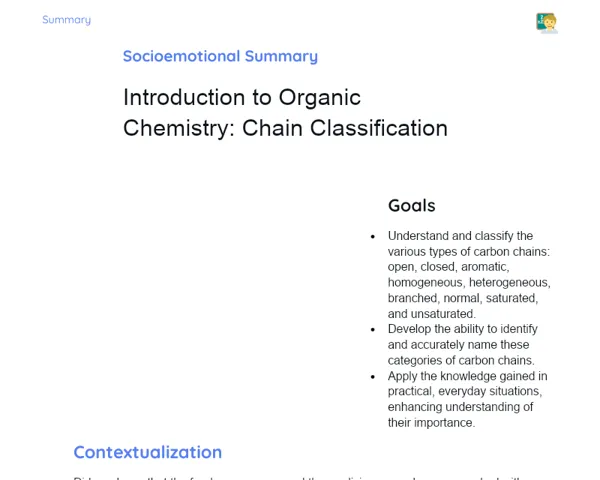Socioemotional Summary Conclusion
Goals
1. Differentiate between aromatic and non-aromatic compounds.
2. Apply Hückel's rule to check if a compound is aromatic.
3. Identify properties of aromatic compounds.
Contextualization
🌟 Did you know that many fragrances we adore, like those in perfumes or the delicate scent of flowers, are tied to aromatic compounds? 🎨 These compounds are not just notable for their aromas but also for their incredible stability and diverse applications, ranging from medicine to dyes! Let's explore this intriguing area of organic chemistry and learn how to recognize and appreciate these remarkable compounds! 💡
Exercising Your Knowledge
Aromatic Compounds
Aromatic compounds are hydrocarbons that feature benzene rings in their structures. These compounds are known for their chemical stability and play key roles in various day-to-day applications. From essential medicines to pleasant fragrances, aromatic compounds are integrated into our daily lives. Their stability stems from the delocalization of electrons within the ring, ensuring a balanced charge distribution.
-
Definition and Structure: Aromatic compounds include at least one benzene ring, which is a hexagonal ring with alternating double bonds.
-
Common Examples: Benzene, toluene, and naphthalene are often encountered examples of aromatic compounds.
-
Stability: The delocalization of π electrons in their rings makes aromatic compounds more stable.
Hückel's Rule
Hückel's rule helps in determining if a compound is aromatic. It states that for a compound to be aromatic, it must contain (4n + 2) π electrons, with n being a non-negative integer. This rule elucidates why aromatic compounds exhibit greater stability: the delocalization of π electrons gives a more stable charge distribution.
-
Aromaticity Criterion: For aromaticity, the compound must possess (4n + 2) π electrons, where n is a non-negative integer.
-
Meaning of n: This integer in the formula aids in predicting the required number of π electrons for stability.
-
Examples: For benzene, the value of n is 1, resulting in 6 π electrons, hence satisfying Hückel's rule.
Properties of Aromatic Compounds
Aromatic compounds display distinctive properties and often have vital industrial applications. They are generally very stable and are likely to undergo electrophilic aromatic substitution reactions instead of addition reactions, due to maintaining the stability of the aromatic ring.
-
Chemical Reactions: They primarily engage in electrophilic substitution reactions due to their inherent stability.
-
Practical Applications: Aromatic compounds find uses in pharmaceuticals, perfumes, and as solvents in the chemical industry.
-
Physical Properties: They are usually found as liquids or solids at room temperature, possessing high boiling and melting points.
Key Terms
-
Aromatic Compounds: Hydrocarbons containing benzene rings in their structure.
-
Hückel's Rule: A guideline that assesses aromaticity based on the formula (4n + 2) π electrons.
-
Electrophilic Aromatic Substitution: A prevalent type of chemical reaction for aromatic compounds.
For Reflection
-
🎨 How can we relate the stability of aromatic compounds to emotional stability? Can we find insights about personal equilibrium by observing the way electrons facilitate stability in an aromatic ring? 💡
-
🤔 Recall a scenario where you collaborated in a group, such as during our compound analysis exercise. How did that make you feel? What strategies did you use to manage those emotions, and how do they influence your interactions with others? 👫
-
🌍 Aromatic compounds have numerous practical applications. Which one do you find most fascinating, and why? How does this application influence our everyday lives and society? 💊
Important Conclusions
-
Aromatic compounds boast stable structures due to the delocalization of electrons in their benzene rings.
-
Understanding Hückel's rule is key for identifying a compound's aromaticity by using the formula (4n + 2) π electrons.
-
Unique properties of aromatic compounds lead to their widespread use in various sectors, including pharmaceuticals and fragrances.
-
Gaining knowledge about aromatic compounds enhances our understanding of chemistry and underscores their significance in our daily lives.
Impacts on Society
Aromatic compounds significantly influence our daily lives. They appear in numerous products we frequently use, from crucial medicines to fragrances that bring us sensory pleasure. Grasping the chemistry behind these compounds allows us to appreciate the scientific principles involved in developing and using products that promote our health and well-being.
On an emotional level, discovering and studying these compounds can elicit feelings of wonder and curiosity. By acknowledging the contributions these compounds make to our lives, we foster greater respect for science and chemistry, motivating us to explore further and potentially pursue careers in this captivating field.
Dealing with Emotions
While studying aromatic compounds, it's helpful to reflect on how you felt during this learning experience. 🧠 Start by identifying the emotions that surfaced during your studies (like frustration, curiosity, or satisfaction). Understand what triggered these feelings (perhaps a challenging concept caused frustration, or a practical application sparked curiosity). Accurately label these emotions. Subsequently, think of effective ways to express them, whether by discussing with a friend or jotting down your thoughts. Finally, consider strategies for managing these emotions, maybe by designing a study plan that includes breaks for relaxation or seeking help when necessary. 💪
Study Tips
-
📚 Create flashcards with definitions and examples of aromatic compounds along with Hückel's rule.
-
🎥 Watch educational videos on aromatic compounds to gain a clearer visualization of their structures and reactions.
-
📝 Engage in practical exercises to identify aromatic compounds using Hückel's rule, reinforcing your understanding.

